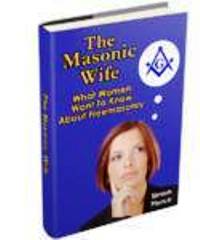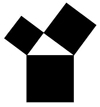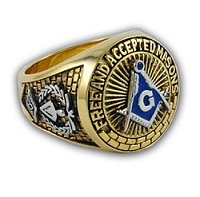Masonic Mosaic Pavement
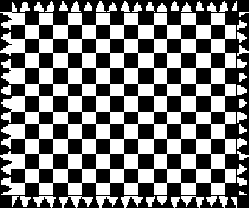
What exactly is the Masonic Mosaic Pavement?
Mosaic pavement,...Are its edges tarsellated, tessellated or tassellated?
Here is what Albert Mackey, noted American Masonic historian and scholar had to say about our Mosaic flooring, in which he defines the difference between "tarsel", "tessel" and "tassel".
...from Mackey's Revised Encyclopedia of Freemasonry, 1929:
Mosaic work consists properly of many
little stones of different colors united together in patterns to imitate a
painting. It was much practiced among the Romans, who called it museum, whence
the Italians get their musaico, the French their mosaique, and we our mosaics.
The idea that the work is derived from the fact that Moses used a pavement of
colored stones in the tabernacle has been long since exploded by etymologists. (Etymology is the study of the history of words.)
The Masonic tradition is that the floor of
the Temple of Solomon was decorated with a mosaic pavement of black and white
stones. There is no historical evidence to substantiate this statement. Samuel
Lee, however, in his diagram of the Temple, represents not only the floors of
the building, but of all the outer courts, as covered with such a pavement.
The Masonic idea was perhaps first suggested by this passage in the Gospel of Saint John xix, 13, "When Pilate, therefore, heard that saying, he brought Jesus forth, and sat down in the judgment-seat in a place that is called the Pavement, but in the Hebrew, Gabbatha." The word here translated Pavement is in the original Lithostroton, the very word used by Pliny to denote a mosaic pavement.
The Greek word, as well as its Latin equivalent is used to denote a pavement formed of ornamental stones of various colors, precisely what is meant by a Mosaic Pavement. There was, therefore, a part of the Temple which was decorated with a mosaic pavement. The Talmud informs us that there was such a pavement in the Conclave where the Grand Sanhedrin held its sessions.
By a little torsion of historical accuracy, the Freemasons have asserted that the ground floor of the Temple was a mosaic pavement, and hence as the Lodge is a representation of the Temple, that the floor of the Lodge should also be of the same pattern. The mosaic pavement is an old symbol of the Order.
It is met with in the earliest Rituals of the eighteenth century. It is classed among the ornaments of the Lodge in combination with the indented tassel and the blazing star. Its parti-colored stones of black and white have been readily and appropriately interpreted as symbols of the evil and good of human life.
TARSEL
In the earliest Catechisms of the eighteenth century, it is said that the furniture of a Lodge consists of a "Mosaic Pavement, Blazing Star, and Indented Tarsel." In more modern catechisms, the expression is "indented tassel," which is incorrectly defined to mean a tessellated border.
Indented Tarsel is evidently a corruption of indented tassel, for a definition of which see Tessellated Border.
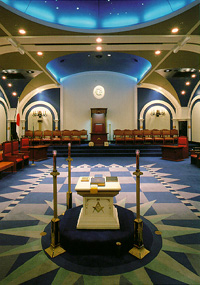
Mosaic Pavement, Blazing Star In the Lodge
TARSEL BOARD
We meet with this expression in some of the old Catechisms as a corruption of Trestle-Board.
TASSELS
In the English and French Tracing Boards of the First Degree, there are four tassels, one at each angle, which are attached to a cord that surrounds a tracing-board, and which constitutes the true tessellated border.
These four cords are described as referring to the four principal points, the Guttural, Pectoral, Manual, and Pedal, and through them to the four cardinal virtues, Temperance, Fortitude, Prudence, and Justice (see Tessellated Border, also Tulith).
The Hebrew word tsitsith means both fringes and tassels in the Old Testament.
Note Deuteronomy (xx, 12), where the older translation has fringes and the Revised Version gives borders, the latter agreeing with border of Mark (vi, 56) and Luke (viii, 44). Where the Revised Version has "border" throughout, the Authorized Version has "hem" in Matthew (ix, and xiv 36).
As symbols of great importance, their use was ordered in Numbers (xv, 3S, 40), "Speak unto the children of Israel, and bid them that they make them fringes in the borders of their garments, throughout their generations, and that they put upon the fringe of the borders a ribband of blue: That ye may remember, and do all my commandments, and be holy unto your God."
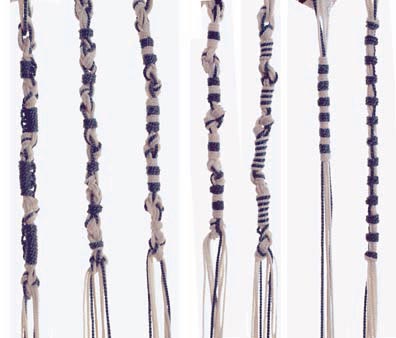
Tassels (Fringes) Worn Upon Jewish Garments, Today
Simon-Sez: For more information about
the fringes and tassels (tsitsith), mentioned in first the Jewish Torah and
later in the Christian Old Testament, which are still worn by the Jews, today,
see my page,
Masonic
Blue.
Now, back, to Dr. Mackey's dissertation about the Masonic Mosaic Pavement.
"TESSELATED
From the Latin "tessela", a little square stone. Checkered, formed in little squares of Mosaic work. Applied in Masonry to the Mosaic pavement of the Temple and to the border which surrounds the tracing board, probably incorrectly, in the latter instance.
TESSELATED BORDER
Browne says in his Master Key,
which is supposed to present the general form of the Prestonian lectures, that
the ornaments of a Lodge are the Mosaic Pavement, the Blazing Star, and the
Tesselated Border; and he defines the Tessellated Border to be "the skirt-work
round the Lodge".
Webb, in his lectures, teaches that the ornaments of a Lodge are the
Mosaic pavement, the indented tessel, and the blazing star; and he defines the
indented tessel to be that "beautifully tessellated border or skirting which
surrounded the ground-floor of King Solomon's Temple."
The French call it "la houpe dentelee," which is literally the "indented
tessel"; and they describe it as "a cord forming true-lovers' knots, which
surrounds the tracing-board."
The Germans call it "die Schnur von starken Faden," or the "cord of
strong threads", and define it as a border surrounding the tracing-board
of an Entered Apprentice, consisting of a cord tied in lovers' knots, with two
tassels attached to the ends.
The idea prevalent in America, and derived from a misapprehension of the plate in the Monitor of Cross, that the tessellated border was a decorated part of the Mosaic pavement, and made like it of little square stones, does not seem to be supported by these definitions. They all indicate that the "tessellated border" was a cord.
Mosaic Pavement Symbolism: The interpretation of its symbolic
meaning still further sustains this idea.
Browne says "it alludes to that kind care of Providence which so cheerfully surrounds and keeps us within its protection whilst we justly and uprightly govern our lives and actions by the four cardinal virtues in divinity, namely temperance, fortitude, prudence, and justice." This last allusion is to the four tassels attached to the cord.
Webb says that it is "emblematic of those blessings and comforts which surround us, and which we hope to obtain by a faithful reliance on Divine Providence."
The French ritual says that it is intended "to teach the Mason that the society of which he constitutes a part surrounds the earth, and that distance, so far from relaxing the bonds which unite the members to each other, ought to draw them closer."
Lenning says that it symbolizes the fraternal bond by which all Masons are united.
But Gadicke is more precise. He defines it as "the universal bond by which every Mason ought to be united to his brethren," and he says that "it should consist of sixty threads or yarns, because, according to the ancient statutes, no Lodge was allowed to have above sixty members."
Oliver (Landm., i., 174) says "the Tracing-Board is surrounded by an indented or tesselated border...at the four angles appear as many tassels." But in the old English tracing-boards, the two lower tassels are often omitted. They are, however, generally found in the French.
Lenning, speaking, I suppose, for the German, assigns to them but two. Four tassels, are, however, necessary to complete the symbolism, which is said to be that of the four cardinal virtues.
The tessellated, more properly, therefore, the tasellated border consists of a cord intertwined with knots, to each end of which is appended a tassel. It surrounds the border of the tracing-board, and appears at the top in the following form:"
Simon-Sez: The image of this form is omitted due to my lack of the proper graphic. The graphic shows the 2 knots and 2 tassels.
The graphic may be found on page 778 of Mackey's Revised Encyclopedia of 1929. Thank you.
Back to Dr. Mackey.
"There is, however, in these old tracing-boards another border, which surrounds the entire picture with lines, as in the following figure:"
Simon-Sez: The image of this form is also omitted due to my lack of the proper graphic. The graphic shows the black and white triangles which make up the border.
The graphic may be found on page 778 of Mackey's Revised Encyclopedia of 1929. Back to Dr. Mackey.
"This indented border, which was made to represent a cord of black and white threads, was, I think, in time mistaken for tessellae, or little stones; an error probably originating in confounding it with the tesselated pavement, which was another one of the ornaments of the Lodge.
We find that we have for this symbol five
different names:
...in English, the indented tarsel, the indented tassel, the indented tessel, the tassellated border, and the tessellated border;
...in French, the houpe dentelee, or indented tessel; and,
...in German, the Schnur von starken Faden, or the cord of strong threads.
The question what is the true tessellated border would not be a difficult one to answer, if it were not for the variety of names given to it in the English rituals. We know by tradition, and by engravings that have been preserved, that during the ceremonies of initiation in the early part of the last century, the symbols of the Order were marked out in chalk on the floor, and that this picture was encircled by a waving cord.
This cord was ornamented with tassels, and formerly a border to the tracing on the floor was called the indented tassel, the cord and the tufts attached to it being the tassel, which, being by its wavy direction partly in and partly outside of the picture, was said to be indented. This indented tassel was subsequently corrupted by illiterate Masons into indented tarsel, the appellation met with in some of the early catechisms.
Afterward, looking to its decoration with tassels and to its position as a border to the tracing-board, it was called the tassellated border.
In time, the picture on the floor was transferred to a permanent tracing-board, and then the tassels were preserved at the top, and the rest of the cord was represented around the board in the form of white and black angular spaces. These were mistaken for little stones, and the tassellated border was called, by a natural corruption, the tessellated border.
Many years ago, when I first met with the idea of this corruption from tassellated to tessellated, which was suggested to Dr. Oliver by "a learned Scottish Mason," whose name he does not give, I was inclined to doubt its correctness.
Subsequent investigations have led me to change that opinion. I think that I can readily trace the gradual steps of corruption, and change from the original name indented tassel, which the early French Masons had literally translated by houpe dentelee, to indented tarsel, and sometimes, according to Oliver, to indented trasel; then to tassellated border, and finally to tessellated border, the name which it now bears.
The form and the meaning of the symbol are
now apparent. The tessellated border, as it is called, is a cord,
decorated with tassels, which surrounds the tracing-board of an Entered
Apprentice, the said tracing-board being a representation of the Lodge, and it
symbolizes the bond of love---the mystic tie---which binds the Craft wheresoever
dispersed into one band of brotherhood."
(End of Dr. Mackey's dissertation about the Mosaic Pavement.)
Mosaic Pavement Carpet on Amazon.com

5 Fast Methods To Find the Information You Want to Learn About
- Search Box - Use the Search Box at the top of your page.
- Site Map - Use my Site Map page to find the topics you are most interested in.
- Carousel - Use the carousel of pages at the top of your screen.
- Menu Icon - On MOBILE, click the MENU button at the top of each page.
- Masonic Books - Browse through a selection of Masonic books.
